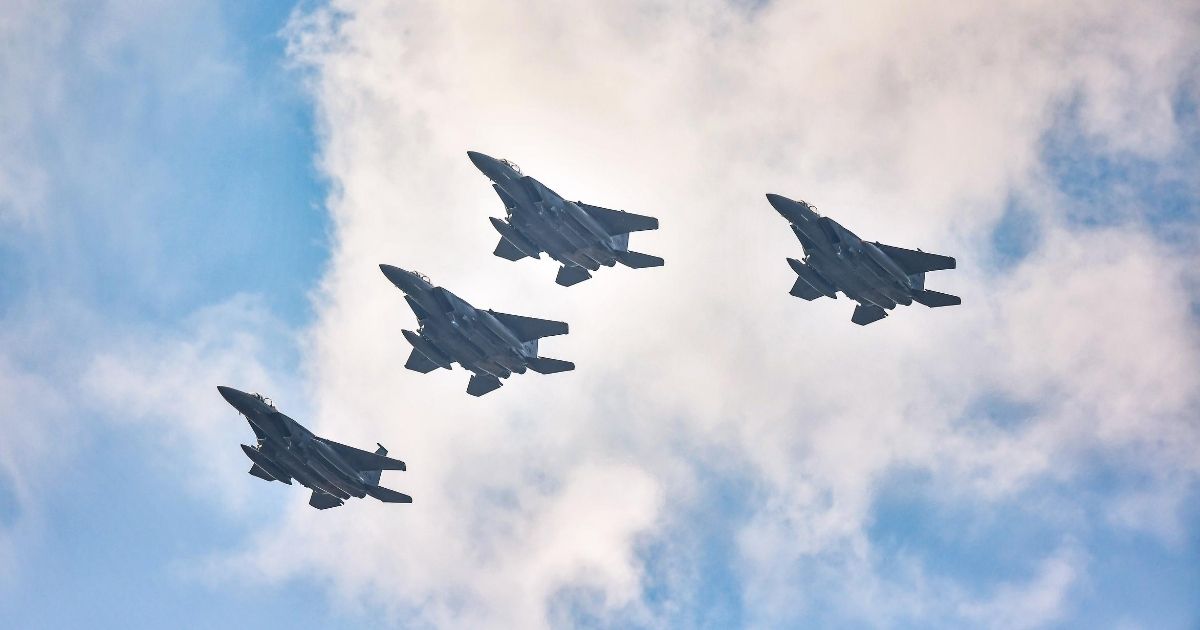
Months After Shooting Down an Airliner Filled with Civilians, Iran Calls Harmless U.S. Fighter Move 'Terrorist Act'
If there’s any country that probably shouldn’t be playing the righteous indignation card over an American jet fighter doing a visual inspection of one of the country’s airliners from a safe distance, it’s Iran.
It’s difficult to remember because 2020 is a year that feels about as blurry as 10 p.m. feels to Johnny Depp, but less than eight months ago, Iran shot down Ukraine International Airlines Flight 752 as it departed Tehran Imam Khomeini International Airport because Iran’s armed forces thought it was a hostile target.
Why did they think the Boeing 737 posed a threat? Iran had just launched its reciprocal attack against an American air base over our targeted strike that killed Islamic Revolutionary Guard Corps Maj. Gen. Qasem Soleimani.
That strike, probably purposely, didn’t do much damage. However, it’s speculated they thought the Ukraine International Airlines flight was, while on a correct flight path, close to sensitive Iranian missile sites they thought the United States might target, which therefore meant we were striking back.
So why wasn’t Iran’s airspace closed ahead of its reciprocal attack?
Um, good question.
“We had requested several times that the country’s airspace become clear of all flights,” IRGC head General Amir Ali Hajizadeh said in the immediate wake of the January shootdown. “Requests were made, but due to some considerations it was not done, and at the same time with the flights, the war situation continued to exist.”
Experts who talked to the Canadian Broadcasting Corporation for a March article, meanwhile, suggested the hundreds of thousands of dollars Iran makes daily from overflight fees led to the fateful decision.
Iran has no business complaining about the fact American F-15 jets conducted a harmless visual inspection of a Mahan Air Airbus A310 over Syrian airspace on July 23, particularly given the problematic history of Mahan Air.
But nevertheless, Tehran is freaking out about it, especially after video onboard the plane showed the pilot making a dramatic evasive maneuver that almost certainly was unnecessary.
This was the video onboard the plane, as released by Iran’s state IRIB news agency:
Passengers on board Mahan Air flight to Beirut injured after crew performs abrupt manoeuvre to avoid two fighter jets over Syria. https://t.co/SPf3MpG1S8 pic.twitter.com/0U2BFg2Mx9
— Breaking Aviation News & Videos (@breakingavnews) July 23, 2020
According to The Associated Press, Mahan Air Flight 1152 landed safely in Beirut, its destination, where some passengers were treated for minor injuries.
The A310 had passed near the al-Tanf garrison in Syria — which, according to the Military Times, is an American outpost crucial to operations against the Islamic State group.
In a statement, senior Central Command spokesman Captain Bill Urban said the American planes “conducted a standard visual inspection of a Mahan Air passenger airliner at a safe distance of about 1,000 meters (3,280 feet) from the airliner this evening.”
“The visual inspection occurred to ensure the safety of coalition personnel at al-Tanf garrison,” Urban said. “Once the F-15 pilot identified the aircraft as a Mahan Air passenger plane, the F-15 safely opened distance from the aircraft.”
The safe operating distance for planes at that altitude is 600 meters, or about 2,000 feet.
Nevertheless, Iran said the plane had been “harassed” by the American F-15s.
Iranian Road Minister Mohammad Eslami said the country had lodged a complaint with the International Civil Aviation Organization, according to Reuters, calling the inspection a “terrorist act, one of aggression.”
Vice President for Legal Affairs Laya Joneydi, meanwhile, called the incident “harassment of a passenger plane” and a “clear violation of aviation security.”
“The explanations provided so far (by the U.S. military) are unjustified and unconvincing,” she said.
These are darkly ironic words if you consider the fact shooting down a plane is a “clear violation of aviation security” and that Iran gave “unjustified and unconvincing” explanations about why Ukraine International Airlines Flight 752 had crashed for several days (none of which, naturally, included it being shot down) before they finally owned up to downing the plane and killing 176 people.
And then there were Iranian officials who implicitly blamed President Trump.
“The security of West Asia should not become a plaything in the U.S. election campaign,” said Iran Foreign Ministry spokesman Abbas Mousavi.
“Iran won’t leave any hostile move against its nation unanswered and shall respond decisively and appropriately to any irrational move in due time.”
Foreign Minister Javad Zarif, meanwhile, said in a tweet that “[t]hese outlaws must be stopped before disaster.”
U.S. illegally occupies territory of another State and then harasses a scheduled civil airliner—endangering innocent civilian passengers—ostensibly to protect its occupation forces.
Audacity to compound lawlessness upon lawlessness
These outlaws must be stopped before disaster.
— Javad Zarif (@JZarif) July 24, 2020
If you think a visual inspection of the airliner wasn’t worth ratcheting up tensions over, for whatever reason, let’s also note that Mahan Air occupies a unique role as one of the world’s only terrorist airlines.
“The United States designated Mahan Air for sanctions in 2011 for providing financial, material, and technological support to the Islamic Revolutionary Guard Corps-Qods Force (IRGC-QF), which was designated by the United States in 2007 for providing material support to terrorism,” a U.S. government fact sheet on the airline reads.
“Mahan Air has flown IRGC-QF operatives, weapons, equipment, and funds to international locations to support Iranian terrorist proxy groups. It has been used by the IRGC-QF to fly personnel to and from Iran and Syria for military training, facilitating covert travel of IRGC-QF members by bypassing normal security procedures and flight manifests.
“The airline’s current chairman and chief executive, Hamid Arabnejad Khanooki, is closely associated with the IRGC, specifically with the division that developed into the Qods Force. The United States sanctioned Arabnejad in 2013 for facilitating a shipment of illicit cargo to Syria on Mahan Air aircraft,” it continues.
“Mahan Air has routinely flown fighters and materiel to Syria to prop up the Assad regime. Iran’s military support for Assad has contributed to mass atrocities in the country, the displacement of millions across the region, and exacerbated the greatest movement of refugees and internally displaced persons since WWII,” the fact sheet says, noting that Tehran’s “use of Mahan Air to support the Assad regime has contributed to incredible human suffering, violence, and political instability felt across the world.”
Germany, Italy and France ban flights from Mahan Air because of its support for terrorism, its close links with the IRGC, as well as its penchant for spying. On that last count, Mahan Air Flight 1152 was overflying the al-Tanf garrison, which could explain a lot, the Asia Times‘ Stephen Bryen postulated.
The United States, he noted, “has established a 55-mile deconfliction zone around the base, which is understood to be a no-go area.
“So why would the airliner choose to conduct a flyover? The answer is revealed, to a degree, by the strange maneuver of the jet. The pilot did not want the F-15s to see something. The F-15s approached the Mahan jet from behind and rapidly overtook it.
“The Mahan flight captain, wanting to avoid a ‘visual inspection,’ made a dangerous move so the F-15s could not see the underbelly of the jet. It is likely the plane was equipped with high-resolution spy cameras that would have been on the underside of the aircraft.”
Bryen noted using airliners as spy planes would hardly be a novel idea.
“The Russians used its national airline, Aeroflot, for precisely this purpose,” he wrote. “So, when Aerofot commercial flights headed from Moscow via Shannon, Ireland, and flew over New York or on to Washington DC, the Russians had a bird’s eye view of US air bases, submarine and aircraft carrier anchorages, and sensitive defense and government facilities including the NSA.”
Given Iran’s support for the Assad regime and its occasional tendency to see how far it can push Washington, al-Tanf would be a potential target, particularly since both Iran and its close ally Russia want the United States out of Syria as quickly as possible.
Whatever the case, Iran is hardly in a position to complain when one of its planes overflies an American base in Syria and then makes a strange evasive maneuver when an F-15 tries to conduct a harmless visual inspection — not after killing 176 people aboard Ukraine International Airlines Flight 752.
The regime doth protest too much, methinks.
Truth and Accuracy
We are committed to truth and accuracy in all of our journalism. Read our editorial standards.
Advertise with The Western Journal and reach millions of highly engaged readers, while supporting our work. Advertise Today.












